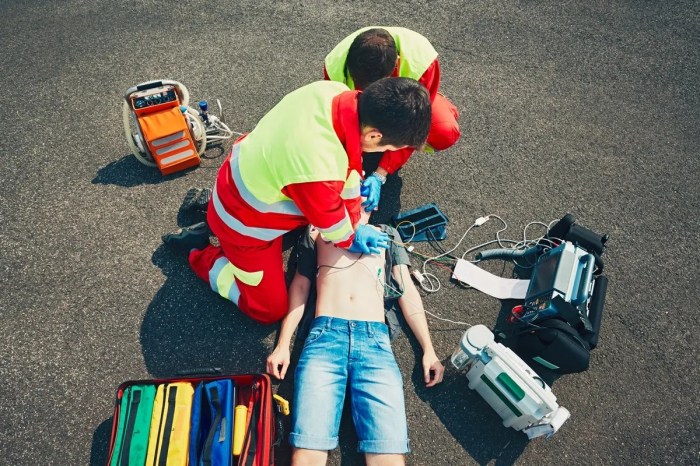ARC CPR AED for the Professional Rescuer, a comprehensive guide to lifesaving interventions, empowers medical professionals with the knowledge and skills to respond effectively to cardiac emergencies. This training program encompasses essential techniques for cardiopulmonary resuscitation (CPR), automated external defibrillation (AED) use, and rescue breathing, equipping professionals to provide immediate and life-saving care.
The Chain of Survival, a crucial concept in emergency response, emphasizes the significance of early recognition of cardiac arrest, prompt initiation of CPR, rapid defibrillation, and timely advanced care. ARC CPR AED training aligns with these principles, ensuring that professionals can seamlessly integrate into this critical sequence.
Definition and Overview
The American Red Cross (ARC) CPR AED (Cardiopulmonary Resuscitation and Automated External Defibrillator) program is a comprehensive training curriculum designed to equip professional rescuers with the skills and knowledge necessary to respond to cardiac emergencies.
The ARC CPR AED program consists of several components, including:
- CPR (Cardiopulmonary Resuscitation): This involves chest compressions, airway management, and rescue breathing.
- AED (Automated External Defibrillator): This is a device that delivers an electric shock to the heart to restore a normal rhythm.
- First aid: This includes basic wound care, bleeding control, and other emergency procedures.
Chain of Survival

The ARC CPR AED program is a critical component of the chain of survival, which is a series of steps that must be taken to improve the chances of survival for victims of cardiac arrest.
The chain of survival includes:
- Early recognition of cardiac arrest
- Early CPR
- Early defibrillation
- Early advanced care
The ARC CPR AED program teaches rescuers how to perform each of these steps quickly and effectively.
CPR Techniques

High-quality CPR is essential for maintaining blood flow to the brain and other vital organs during cardiac arrest.
The ARC CPR AED program teaches rescuers how to perform high-quality CPR, which includes:
- Proper hand placement on the center of the chest
- Compressions at a rate of 100-120 per minute
- Compression depth of at least 2 inches (5 cm)
- Allowing the chest to fully recoil after each compression
- Minimizing interruptions in compressions
AED Use

An AED is a portable device that can deliver an electric shock to the heart to restore a normal rhythm.
The ARC CPR AED program teaches rescuers how to use an AED safely and effectively.
The steps involved in using an AED include:
- Turning on the AED
- Placing the AED pads on the victim’s chest
- Following the AED’s voice prompts
- Delivering a shock if the AED advises it
Rescue Breathing: Arc Cpr Aed For The Professional Rescuer
Rescue breathing is a technique used to provide oxygen to a victim who is not breathing.
The ARC CPR AED program teaches rescuers how to perform rescue breathing using two methods:
- Mouth-to-mouth ventilation
- Bag-valve-mask ventilation
Both methods involve opening the victim’s airway, sealing the victim’s mouth or nose, and providing breaths.
Special Considerations

The ARC CPR AED program also provides guidance on performing CPR and using an AED on infants, children, and special populations.
These considerations include:
- Using smaller hand placement and compression depth for infants and children
- Using a different AED pad placement for children
- Being aware of potential hazards and complications when performing CPR and using an AED on special populations
Training and Certification
Regular ARC CPR AED training and certification is essential for professional rescuers to maintain their skills and knowledge.
The ARC CPR AED training program is typically 4-6 hours long and includes both classroom instruction and hands-on practice.
Upon successful completion of the training program, participants will receive a certification card that is valid for two years.
Legal and Ethical Considerations
Professional rescuers who perform CPR and use an AED have certain legal and ethical responsibilities.
These responsibilities include:
- Obtaining consent from the victim or their legal guardian before performing CPR or using an AED
- Maintaining patient privacy
- Documenting all actions taken during the resuscitation attempt
Case Studies and Simulations
Case studies and simulations are valuable tools for professional rescuers to practice their CPR and AED skills.
These exercises allow rescuers to apply their knowledge and skills in a realistic setting.
Debriefing after case studies and simulations is essential for rescuers to learn from their experiences and improve their performance.
Resources and Further Reading
There are a number of reputable resources available for additional information on ARC CPR AED.
FAQ Guide
What are the key components of ARC CPR AED training?
ARC CPR AED training encompasses high-quality CPR techniques, proper AED use, rescue breathing methods, and an understanding of the Chain of Survival.
How does ARC CPR AED align with the Chain of Survival?
ARC CPR AED training emphasizes the importance of early recognition, immediate CPR, rapid defibrillation, and timely advanced care, aligning with the principles of the Chain of Survival.
Why is regular ARC CPR AED training crucial for professional rescuers?
Regular training ensures that professional rescuers maintain proficiency in CPR and AED use, stay updated on best practices, and enhance their ability to respond effectively to cardiac emergencies.